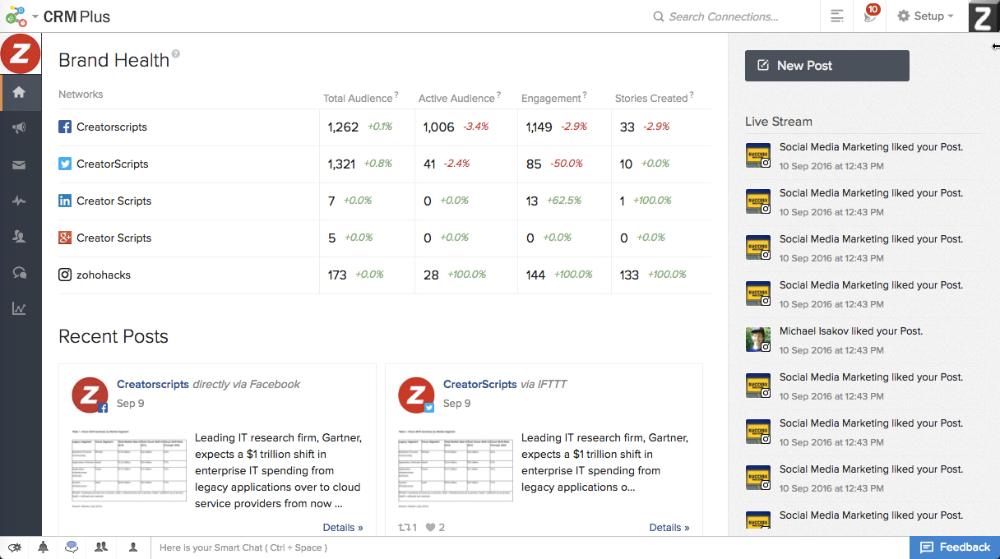There are software providers that specialize in just one area of business operations and productivity, and then there are the companies that cover every enterprise base within one ecosystem. Zoho is in the latter category. The cloud-based office suite and Software-as-a-Service (SaaS) provider is known for products like Zoho CRM, Zoho Projects, Zoho Campaigns, and a slew of other business apps and services. But in 2015, the company entered the social media management and analytics arena as well with Zoho Social (which begins at $10 per month for the Standard plan).
Zoho Social is a full-featured, responsive hub for managing your social operations and tracking key metrics. It's ideally suited for small to midsize businesses (SMBs) looking to curate and monitor a single brand across Google+, Facebook, Twitter, LinkedIn, or Instagram. It's also ideally suited for small to midsize enterprises (SMEs) managing up to three different brands that are looking to track core internal metrics and external reporting on specific social networks. While its broader social listening capabilities and depth of reporting data can't match the global enterprise scale of Editors' Choices Synthesio and Sysomos, Zoho can also do a lot more on the publishing and CRM integration front, and at a bargain price.
Pricing and Setup Zoho Social is free for a single user and brand, with basic social publishing functionality (though with no Instagram access). But the real features begin in the $10 per month Standard plan, which includes two users, publishing and scheduling, and basic monitoring, reporting, and collaboration features. Local SMBs looking for the basics might be suited to this tier but, for most businesses, you'll need the $50-per-month Professional plan. Compared to $99 per month for Sprout Social or Buffer for Business, Zoho Social is a bargain.
The Professional plan comes with five users, three brands, and premium features such as advanced and custom reporting, sentiment analysis, and up to 15 columns in the Monitoring tab. Though beyond those relatively small user and brand caps, businesses will need to pay $10 per month for every additional user or brand. Zoho Social also offers a yearly pricing option, where businesses can pay $100 upfront for the Standard plan or $500 for the Professional plan to get two free months.
Once you sign up for Zoho Social, you're prompted to connect all these networks you see on the home screen. As far as supported social networks, the platform keeps it simple. Zoho Social supports Facebook, Twitter, LinkedIn, Instagram, and Google+. There's no support for other social networks including Pinterest, YouTube, Tumblr, and others—Zoho focuses on the core sites for businesses. The rest of the setup is pretty simple. Once you authorize Zoho Social for any given social network, that account is then added to the main dashboard, where you can tab back and forth between your different "brands."
Interface and Social Media Management Zoho Social sports a clean user interface (UI) broken down into seven main tabs accessible from the left-hand vertical navigation bar, which expands and contracts when a mouse hovers over it. The tabs are straightforward, with icons for Home, Posts, Messages, Monitor, Connections, Collaborate, and Reports, but the first thing you see on the Home tab is a Brand Health dashboard.
The dashboard is essentially a table showing key metrics—total audience, active audience, engagement, and the number of "stories" or posts created—each with a red or green plus/minus percentage next to them showing week-to-week change. It's a brand's social report card. This is a great little feature for novice social media editors or brand managers to easily gauge social brand progress and report to their superiors with a few key hard numbers.
On the right of the dashboard is a live stream column showing the most recent brand engagement of any kind of any network. The Interactions tab shows a full list of user engagement, but the live stream tab is good for quick influencer identification and engagement. Click on a message and you'll get a pop-up window with profile info—friends and followers, who they're following, likes—and immediately reply with a comment, tweet, direct message, etc. The Home dashboard does a good job of putting quick actions and key metrics at a user's fingertips, rather than inundating the UI with all the social data the platform is pulling in.
The Posts tab is where you manage publishing in Zoho Social across brands. The main feed is a fairly simplistic look at Published Posts, which can be filtered by network, sorted by date, or sorted by post popularity. You can also sort by Promoted Posts, if you've paid for any reach on Facebook or Twitter, or failed posts to reschedule and post again. There is a bulk scheduler option by uploading a CSV, XLS, or XLSX file containing text for a list of posts, but it's not the most intuitive or easy-to-use bulk scheduler I've tested.
The posts do include positive, negative, or neutral sentiment analysis, but only after a given posts hits a volume threshold for engagement. Zoho Social's sentiment analysis is streets behind Crimson Hexagon and Synthesio, but if a post is popular enough, even basic sentiment analysis is one of the most crucial data points in improving a business's social engagement.
To create a post, you press the New Post button on the top right of the tab to open the publishing window. Zoho Social allows you to toggle brands on and off to send a post to one or more networks and customize the message accordingly. You can add a photo, but Zoho is still working on the ability to attach a video to a post. As for scheduling, there's a calendar and publishing time field on the bottom right of the window. One useful feature is the ability to set a post to repeat on specific dates, weekly, or monthly.
Zoho Social's publishing is nothing fancy, but its most innovative feature is the Smart Q, a custom-built Zoho algorithm that monitors social networks and suggests the optimal time to publish a post. Smart Q recommends the time at which a Facebook, Twitter, Instagram, LinkedIn, etc, audience is the likely to be the most active and engaged. It's the first hint of true automation in the tool, and if you let it, Smart Q will schedule your entire arsenal of social posts for you. It's similar to the automated publishing features and recommendations in Buffer for Business, but without the drag-and-drop scheduling queue to rejigger post order you'll find in that tool. Zoho's continued experimentation with this kind of smart automation will be key to how the platform evolves in the next several years, as social media managers are overseeing more and more brands, and have less and less time to curate them all.
Social Monitoring, Analytics, and Reporting The Monitor tab is Zoho's hub for all social listening. You can create more than 10 different columns or "streams" reminiscent of the curated social listening experience in Sprout Social and Hootsuite, but one big difference is that—as with the Messages tab aggregating direct interactions across social networks—it's all integrated with Zoho CRM.
When creating your monitoring streams, you can not only add columns such as Facebook page interactions, searches for a specific Twitter keyword, Instagram likes, etc, but also posts or interactions from CRM contacts and leads. You can also set up a stream of another user or page for competitive brand monitoring and analysis purposes.
The CRM integration is also key in the Connections tab, which shows users who've engaged with your brands in any way. It's a more fleshed out version of the live stream column. In this tab you can filter by network, interaction recency, most engaged users, or filter by CRM leads or contacts. More importantly, in the Connections tab you can also add a user as a lead or contact in Zoho CRM with a single button from their user profile. This kind of simple but effective influencer identification and management shows how Zoho has integrated CRM across its social platform. You can go even further in the Settings tab on the top right of the dashboard, where you can automate social lead generation further by clicking into the lead generation module and setting pre-defined rules and triggers that will automatically add leads from Zoho Social into your CRM.
On the reports front, beyond the Brand Health scorecard there is a substantial amount of analytics baked throughout the Zoho Social experience. Scroll down the main dashboard below the report card and you'll see your last post on each social network with the same metrics below each, broken down by network.
If you click on the details button, Zoho will dig into the post details section showing some more metrics like potential reach and link clicks, and give you a more detailed view of post engagement via pie chart. The data differs depending upon network, and you can email out a report of that data via PDF by clicking the Export button.
The Reports tab itself is where you'll find the most detailed social analytics. The basic reports are each specific to social network, but you can create exportable custom reports incorporating stats from different brands and networks. I liked that the reports are all presented in natural, relatable language. Stats differ by social, like a "How is your brand performing?" line graph, or a "Where are your connections located?" bar graph, or a "How many people are talking about your posts?" engagement chart. There are also reports showing associated keywords with a particular brand, a demographic breakdown of the different industries your followers are in, and A/B testing metrics of whether a post worked better with a link, an image, with only text, etc.
There's also a CRM report for users linked to a Zoho CRM account, whichshows leads created, contacts created, potentials, and revenue generated on particular days laid out in a table with the day, lead name, lead contact, and social source. If you click on a particular lead from there, the URL in the browser bar shows a Zoho CRM profile address. While enterprise-grade social listening platforms like Synthesio, Crimson Hexagon, or Talkwalker can run more complex queries on social data, rendered in a wider array of reports, Zoho Social holds its own in the SMB tier, matching Sprout Social and Hootsuite for post-specific analytics, with dead-simple usability on par with Buffer for Business and seamless CRM integration.
A CRM-Integrated Social Collaboration Hub Social media is a collaborative experience within an organization, and Zoho Social gets the idea that colleagues should be able to discuss specific posts, larger trends, and social strategy within the platform. That's why the Collaborate tab is my favorite part of Zoho Social. Throughout the Home, Posts, Monitor, and Reports tabs, each object has not only an "Add to CRM" option when relevant, but a "Discuss" button to embed that object in the Discuss tab for comment. Add a post, a user or lead, or a specific report or chart to the tab, and a discussion can sprout from there in a feed reminiscent of a basic company intranet page for easy discussion.
Zoho Social also offers mobile apps for Android and iOS, and browser extensions for Chrome and Firefox. For the most part, Zoho Social is a standard social media management and analytics platform. The publishing, analytics, and reporting features leave nothing to be desired, but aside from Smart Q automation, there's nothing that'll blow you away. Where the tool really stands out is in its built in CRM and collaboration features, and all at a very low prices for SMBs or SMEs. Zoho Social is an easy-to-use social media management and analytics platform with enough smart publishing and reporting features to satisfy social or brand managers looking for straightforward metrics. If your business is already a Zoho CRM customer, it's a no-brainer.

